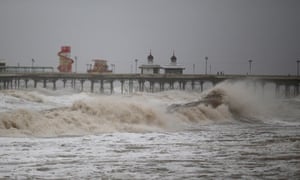Storm Abigail, the first weather system to be given a name under a new Met Office project, is forecast to lash Scotland with severe gales on Thursday and Friday.
While much of Britain continues to enjoy record mild temperatures for November, thanks to south-westerly winds, an Atlantic depression linked with that same weather pattern, is forecast to cause severe gales of 80mph or more for north-west Britain.
The Met Office has issued a yellow – “be aware” – warning for the north and north-west of Scotland with high gusts in exposed areas risking travel disruption. It also warned that Storm Abigail could cause high waves to come over the top of seafronts.
The Met Office said: “A vigorous depression is expected to pass just to the north-west of Scotland on Thursday night bringing a swathe of very strong winds on its eastern and southern flanks.”
Storm Abigail is the first such weather system affecting the British Isles to bear a name as part of the “name our storms” project, using names chosen by the public.
Eddy Carroll, chief meteorologist at the Met Office, said: “We now have our first named storm. It’s called Abigail … and it is expected to come eastwards quite quickly … bringing some very strong winds on its southern flank. There is inevitably some uncertainty about the track it’s going to take and the ultimate intensity it is going to reach but there is quite a lot of evidence that it could be quite a deep feature bringing winds possibly as much as 80mph or more.”
It is hoped the name our storms project, inspired by storm warnings used in the US and elsewhere in the world, will help raise awareness of severe weather and ensure greater safety of the public.
Under the scheme, storms will be named when they are deemed to have the potential to cause a substantial impact in the UK and/or Ireland.
Abigail is the first on the list of winning names, followed by Barney, Clodagh, Desmond, Eva, Frank, Gertrude, Henry, Imogen, Jake, Katie, Lawrence, Mary, Nigel, Orla, Phil, Rhonda, Steve, Tegan, Vernon and Wendy.
On Tuesday the Met Office recorded the warmest November night on record when warm winds meant the temperature in Murlough, County Down, did not drop below 16C. It comes after 1 November broke records as the warmest November day when the temperature in Trawsgoed, Wales, hit 22.3C.
Met Office scientists predict that 2015 will be the hottest year on record. Data from January to September 2015 shows global average temperatures have risen by 1C for the first time compared with pre-industrial times. The rise is due to the influence of increasing carbon emissions combined with the El Niño climate phenomenon currently under way.

No comments:
Post a Comment